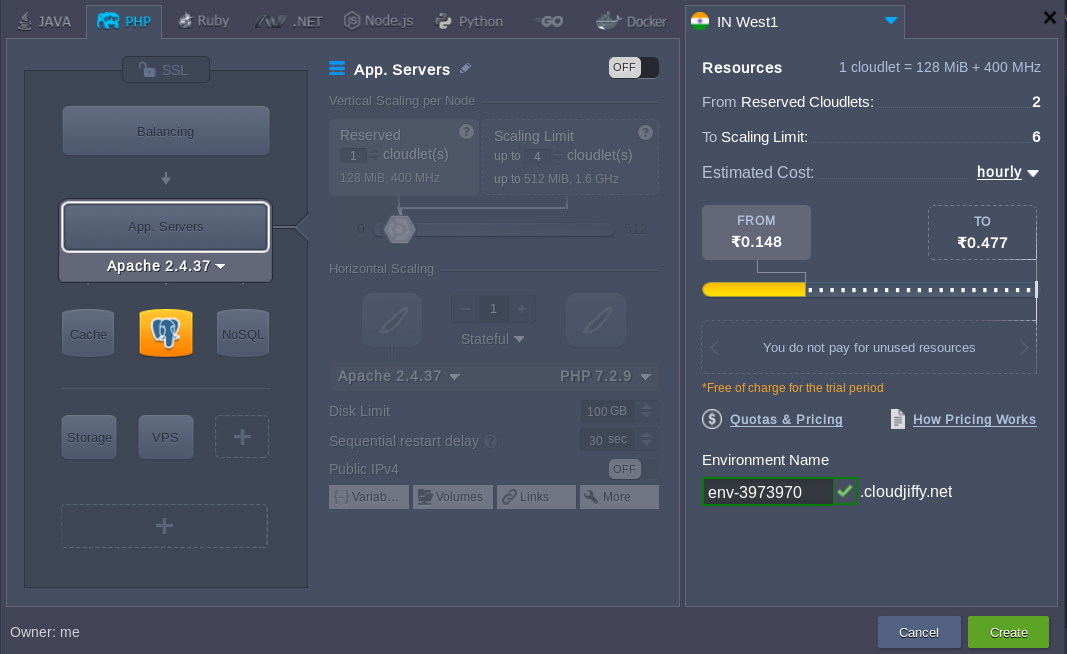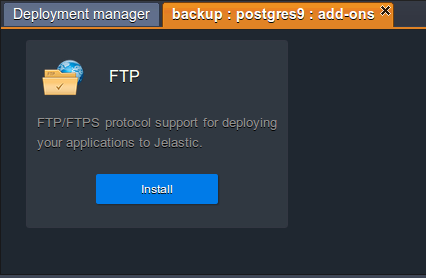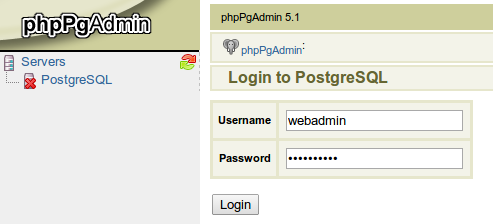-
.Net
-
Backup
-
Data Storage Containers
-
Docker Containers
-
Environment Management
- Swap-Domains
- Clone Environment
- Create Environment
- Environment Aliases
- Environment Aliases
- Environment Migration between Regions
- Environment Regions
- Environment Transferring
- Environment Variable
- Environment Variables
- Environment Variables(Apache meaven, Memcached)
- Environment Variables(Go)
- Environment Variables(JAVA)
- Environment Variables(Load Balancer)
- Environment Variables(Node.js)
- Environment Variables(PHP)
- Environment Variables(Ruby)
- How to Migrate a WordPress Site to BitssCloud PaaS
- How to migrate my environments from another Jelastic provider?
- HTTP Headers
- Java VCS Deployment with Maven
- Setting Up Environment
- Share Environment
- Why is my environment in sleeping mode?
- Show all articles (9) Collapse Articles
-
Java
- Environment Variables - Java custom Environment Variables
- Java App server Configuration
- Java Options and Arguments
- Multiple Domains on Tomcat server
- Secure Java Encryption and Decryption
- Spring Boot Standalone and Clustered Java Applications with BitssCloud
- Timezone Data for Java/PHP App Server
- Tomcat HTTP to HTTPS redirect
- WildFly server
-
LiteSpeed Web Server
-
OOM Killer
-
Python
-
Reseller SetUp
-
Secure Socket Layer (SSL)
-
Troubleshooting
-
Account Management
-
CDN
-
Databases
- Database Configuration
- Database Connection Strings
- Database Hosting in BitssCloud
- Environment Variables(Database)
- Galera Cluster not working
- How to export/Import Database via Command line
- How to install MSSQL server on Linux (2017)
- MariaDB/MySQL Auto-Сlustering
- MongoDB Database Backups
- PostgreSQL Database Backups
- PostgreSQL Database Replication
- PostgreSQL Master-Slave Cluster
- Remote Access to PostgreSQL
- Schedule Backups for MySQL and MariaDB Databases
- Scheduling Databases Backups
-
Domain Name Management
- Container Redeploy
- Custom Domain Name
- DNS Hostnames for Direct Connection to Containers
- How to Bind Custom Domain via A Record
- How to Bind Custom Domain via CNAME
- Multiple Custom Domains on an Nginx Web Server
- Multiple Domains with Public IP
- Multiple Public IP Addresses for a Single Container
- Setup WordPress Multisite Network with Domain Mapping and CDN
-
Jenkins
-
Load Balancing
-
PHP
- Creating Environment for PHP
- Deploy PHP Project Via GIT SVN
- How to Check Change PHP Version in BitssCloud
- How to create environment for AngularJs/ReactJs
- How to Enable PHP Extensions
- How to Install Custom PHP Application
- Ion cube Loader
- MariaDB PHP connection
- MySQL PHP Connection
- NGINX PHP
- PHP App Server Configuration
- PHP Connection to MongoDB
- PHP security settings
- PHP Session Clustering
- PostgreSQL PHP Connection
- Running Multiple Domain Names on Apache Server
- Security configuration for Apache
- Zero Downtime (ZDT) Deployment for PHP
- Show all articles (3) Collapse Articles
-
Release Notes
-
Ruby
-
SSH
-
Wordpress
-
Application Management
-
Cluster
-
Deploying Projects
-
Elastic VPS
- CentOS VPS
- Elastic VPS configuratation
- Elastic VPS with full root access
- Installation of cPanel in BitssCloud
- Java Console Application with CentOS VPS
- Linux VPS Access via Public IP
- Linux VPS Access via SSH Gate
- Setting Mail Server Inside CentOS VPS
- Setting Mail Server Inside CentOS VPS
- SSH Access to VPS Gate
- Ubuntu VPS
- Ubuntu with CSF Firewall
-
High Availability
-
Jitsi
-
Node.js
-
Pricing System
-
Request Handling
-
Scaling
- Application Server with horizontal scaling
- Automatic Horizontal Scaling
- Automatic Horizontal Scaling: Multi Nodes
- Automatic Vertical Scaling
- Database Horizontal Scaling
- Docker Containers Horizontal Scaling
- Horizontal Scaling
- Load Balancer with horizontal scaling
- Memcached horizontal scaling
- Storage Container
- VPS Horizontal Scaling
-
Traffic Distributor
-
General
- Apache & NGINX Modules
- BitssCloud Dashboard Guide
- Build and Deploy Hooks
- Cron Job scheduler
- FFMPEG Setup
- File Synchronization
- FTP Overview
- FTP/FTPS Support in BitssCloud
- How to Deploy Magento into BitssCloud PHP Cloud
- How to Enable Expert Mode in JCA
- How to open a support ticket to BitssCloud
- Installation of FTP
- Kubernetes Cluster
- MarketPlace
- Reduce Cloud Waste with Automatically Scheduled Hibernation
- Run Configuration
- SFTP Protocols for Accessing BitssCloud Containers.
- Supported OS Distributions for Docker Containers
- Timezone Addon
- Two-Factor Authentication
- Types of Accounts
- Varnish
- Websockets Support
- What is Cloudlet
- What is PaaS & CaaS
- WordPress AddOn
- Zero Code Change Deploy with No Vendor Lock-In for Smooth Migration across Cloud Platforms
- Show all articles (12) Collapse Articles
-
Go lang
-
Wordpress category
-
Data Storage Container
-
Memcached
-
Account & Pricing
PostgreSQL Database Backups
Automatic PostgreSQL Backups
The instruction below shows how to configure automatic periodic backups of your application data, stored within the PostgreSQL database. This will ensure the safety of the information it contains in the case of unexpected server failure.
In order to eliminate the necessity to remember to backup and regularly perform the appropriate operations, we’ll use cron, a time-based job scheduler, and runner. It executes the necessary commands at the stated time/date, based on the previously specified scenario.
Thus, follow the step-by-step instruction below in order to get such an automated solution.
Create an Environment
1. Log into your BitssCloud account and click the Create environment button at the top dashboard panel.

2. In the appeared dialog window select the preferable version of the PostgreSQL database (8 or 9) and allocate the required amount of resources for it (use cloudlet sliders in the Vertical scaling wizard section). Then type your environment name (e.g. backup) and click the Create button.

3. Wait just a minute for your environment to be created.

Configure and Schedule Backups
Now let’s configure the backup itself.
1. Click the Config button for your PostgreSQL database.

2. You’ll see the configuration manager opened at the bottom of your dashboard with a list of accessible folders.
Navigate to the var/lib/pgsql/data/pg_hba.conf file and replace its content with the following lines: local all Postgres peer
local all all md5
host all all 127.0.0.1/32 trust
host all all ::1/128 md5
Tip: This file can be quickly accessed through the Favorites list in the file manager:
- for the PostgreSQL 9.6 and higher – click the direct pg_hba.conf shortcut to file
- for the PostgreSQL 9.5 and lower – use the conf redirect to the appropriate folder

Save the changes with the appropriate button above the editor.
3. Then, locate the Postgres file in the cron folder. Modify the next command based on your requirements and add it to this file (e.g. the example below will make the backup once per hour).
* */1 * * * pg_dump > /var/lib/jelastic/backup/backup.sql

In order to get more information on how to configure the desired frequency of reserve copying, see this article (Setting up cron event scheduler section).
4. Save the made changes and Restart your DB node for their appliance.

Check Your Backups
Now let’s check everything was configured properly.
1. Wait for a scheduled amount of time for the backup to be performed.
2. Open the configuration manager for your PostgreSQL server with the button, shown below.

3. The reserve data copy will appear in the backup folder.

| Note: that each newly created backup will override the existing one, i.e. you’ll always see just one file with the latest data. |
Download your Backups
In order to get the ability to download the created backups, you’ll need to connect to your DB server via FTP protocol. Therefore, follow the next steps.
1. Install the FTP-addon to your database. For that, use the detailed instruction in the FTP/FTPS Support guide.

2. Once installation is finished, you receive your FTP credentials in a separate email. Use them in order to establish the connection to your PostgreSQL node through the preferred FTP client (e.g. FileZilla).
3. After you’ve accessed the container’s file system, navigate to the backup folder and download the backup.sql file with your stored data to your local machine.
Restore the Database
In case you need to restore your data from the existing backup file, please perform the following steps.
1. Open the phpPgAdmin panel for the DB server you would like to restore your database to.
2. Enter the credentials you’ve received via email after this PostgreSQL node has been added to your environment.

3. Select the database you want to import the data to (we’ll use the default Postgres one for this example) within the left-hand menu.
Then navigate to the SQL tab and upload the previously-stored backup.sql file with the help of the Choose File button. Click Execute.

As a result, you’ll see your database has been successfully restored.
That’s all! Now you can be confident in your data’s safety, as it is periodically saved and can be restored and reused.
